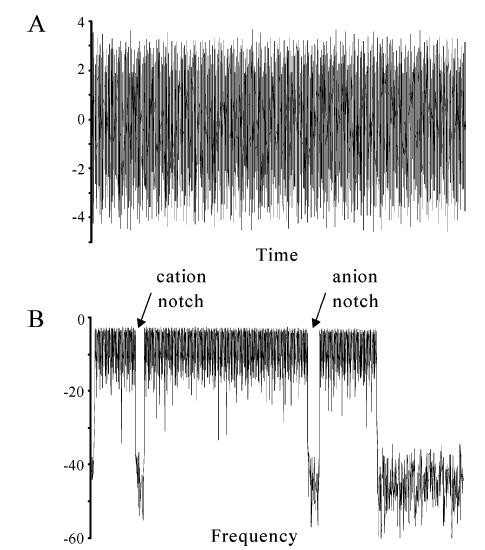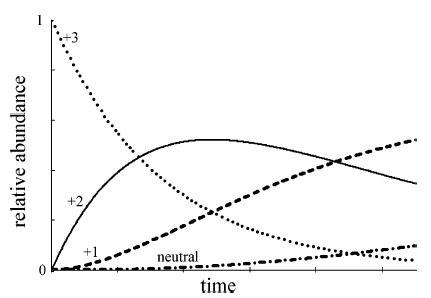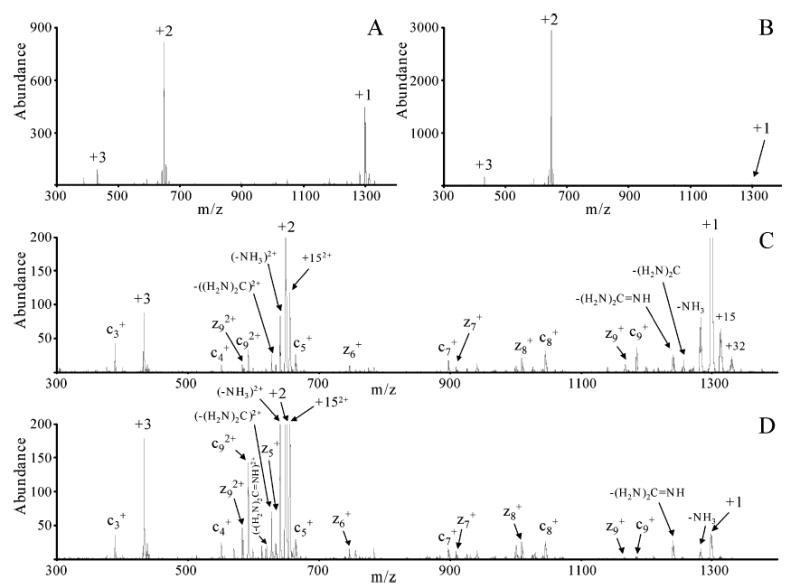Abstract
Electron-transfer dissociation (ETD) in a tandem mass spectrometer is an analytically useful ion/ion reaction technique for deriving polypeptide sequence information, but its utility can be limited by sequential reactions of the products. Sequential reactions lead to neutralization of some products, as well as to signals from products derived from multiple cleavages that can be difficult to interpret. A method of inhibiting sequential ETD fragmentation in a quadrupole ion trap is demonstrated here for the reaction of a triply protonated peptide with nitrobenzene anions. A tailored waveform (in this case, a filtered noise field) is applied during the ion/ion reaction time to accelerate simultaneously first-generation product ions and thereby inhibit their further reaction. This results in a ~50% gain in the relative yield of first-generation products and allows for the conversion of more than 90% of the original parent ions into first-generation products. Gains are expected to be even larger when higher charge-state cations are used, as the rates of sequential reaction become closer to the initial reaction rate.
Electron capture dissociation (ECD)1,2 and electron-transfer dissociation (ETD)3–5 are two analytically useful techniques for obtaining polypeptide amino acid sequence information. For ECD, the electron capture cross section is predicted to be dependent on the square of the cation charge.6 A similar rate dependence upon charge has been observed for ion/ion reactions.7 A complication associated with both ECD and ETD, as currently practiced, is the possibility for sequential electron capture or electron-transfer reactions. For example, first-generation products can undergo sequential reactions that lead to higher-generation products to the point where, in the extreme case, all cations are neutralized. Such sequential reactions are problematic because they can decrease the overall signal level of informative fragment ions and create spectral complication due to the appearance of internal fragment ions. According to Gorshkov et al.,8 the maximum obtainable fragmentation efficiency in ECD is 43.75% for doubly charged ions and is not likely to exceed 50% for higher charge states, while Zubarev et al.6 have reported that ECD efficiency is usually ≤30%. Furthermore, it has been suggested that secondary internal product ions are minimal when a significant amount of the precursor ion remains unreacted and the maximum efficiency is reached when two-thirds of the precursor ions have reacted.6,9 Ideally, however, it is desirable to convert all precursor ions into structurally informative products. To this end, it is desirable to minimize contributions from second- and higher-generation sequential reactions while maximizing the fraction of parent ions that undergo reaction.
It has been shown that rates of selected ion/ion reactions in a quadrupole ion trap can be inhibited by applying a single-frequency dipolar resonance excitation voltage to the end caps, in a process termed “ion parking”.10 This method is effective for parking ions of a selected m/z ratio, as the resonant excitation increases the velocities of the selected ions, greatly reducing their reaction rates and also reducing the spatial overlap of oppositely charged ions. Alternatively, Grosshans et al. have employed the use of a dipolar dc voltage across the end caps to control charge neutralization in a quadrupole ion trap mass spectrometer.11,12 The method is effective at parking ions above a selected m/z ratio, by physically separating the cation and anion clouds on the basis of pseudopotential well depth, which is related to m/z ratio under a fixed set of ion storage conditions. A third method of ion parking is demonstrated here to inhibit sequential ETD fragmentation in a quadrupole ion trap. It is based on parking all ions other than those in selected regions of m/z. Since this method is intended to inhibit simultaneously the reactions of ions of disparate m/z ratios, it is referred to as “parallel ion parking”. The concept involves the continuous application of a tailored waveform during the ion/ion reaction period that does not affect the reagent anion and analyte cation but leads to the parking of all first-generation product ions with m/z values that differ significantly from those of the reactants. We illustrate the experiment here using a filtered noise field (FNF)13,14 waveform to resonantly accelerate ions over a broad m/z range. If the FNF waveform is chosen so that it accelerates all ions other than the desired cation and anion, then it will allow one reaction to occur, but inhibit further reaction by any products that fall within the range of ions that undergo acceleration. An example of the time and frequency domain of such a waveform is shown in Figure 1, with the indicated frequencies excluded so that the reactant ions are not excited. We demonstrate this concept with ETD reactions of a multiply protonated peptide.
Figure 1.

Example of a FNF waveform in the (A) time domain and (B) frequency domain.
EXPERIMENTAL SECTION
Methanol and glacial acetic acid were purchased from Mallinckrodt (Phillipsburg, NJ). Angiotensin I, RKRARKE, and nitrobenzene were obtained from Sigma (St. Louis, MO). Neurotensin was obtained from Bachem (King of Prussia, PA). All experiments were performed on a Hitachi (San Jose, CA) M-8000 3-DQ ion trap mass spectrometer adapted for ion/ion reactions as described previously.15 In a typical experiment, peptide cations were formed using nanoelectrospray5 and injected into the ion trap for ~1 s. Nitrobenzene anions were formed using atmospheric sampling glow discharge ionization and introduced via a hole in the ring electrode (~50 ms).16 Ion/ion reactions were allowed to take place for a given period (~300 ms) during which an FNF waveform generated by the instrument software can be used to inhibit the further reaction of product ions. Mass analysis was performed by resonance ejection. Spectra shown here are an average of ~250 scans.
RESULTS AND DISCUSSION
The charge squared dependence of ion/ion reactions has important implications for the time evolution of different generation products derived from a given starting population. In the case of ion/ion reactions that lead to reduction of charge without any dissociation, the relative amounts of the different products are straightforward to predict. Assuming that reaction rates scale with the square of the charge of the cation (singly charged anion case) and that there is a large excess of anions, pseudo-first-order kinetics can be assumed7 and a plot such as that of Figure 2 applies. In this case, a starting population of +3 ions is converted to +2, +1, and neutral products. The maximum relative quantity of +2 ions that can be formed is ~50% of the initial ion population, and this will occur when the quantity of unreacted ions (the +3 ions) is approximately equal to that of the ions that have reacted twice (the +1 ions). Ion parking with a single frequency has been demonstrated as a means of converting nearly all of the initial ion population into first-generation products with minimal formation of higher-generation products in nondissociative reactions.10
Figure 2.

Simulation of ion abundances for reactions between a triply charged cation and a singly charged anion assuming a reaction rate dependence on charge squared and no fragmentation.
In a case like electron transfer, where each reaction step can lead to fragmentation along with the charge reduction, the picture is more complex. A +3 ion can react and fragment to form a +2 product ion and a neutral product molecule, or it can react and fragment to form two +1 product ions, and the two cases will result in different subsequent reaction rates for the first-generation product. This complicates quantitative prediction of the point at which the maximum amount of first-generation products will be present and what the maximum amount will be. Nevertheless, as long as the rates of subsequent reactions are appreciable, a maximum in the amount of first-generation products that can be formed cannot approach 100%. A means for inhibiting the reaction rates of all first-generation product ions simultaneously would allow for the formation of first-generation products to approach 100%. Figure 3 demonstrates the use of tailored waveforms for this purpose. In Figure 3A, the reaction of angiotensin I (M + 3H)3+ ions with nitrobenzene anions is shown. Reaction occurs through a mixture of proton transfer without dissociation and electron transfer both with and without dissociation. Reaction without dissociation leads to the peptide ions with reduced charge states. Dissociation leads to the variety of c- and z-type sequence ions, as well as a variety of small-molecule losses. Figure 3B shows the same reaction with an FNF applied to resonantly excite all ions between m/z 480 and 2000, thereby reducing their ion/ion reaction rates. Spectra C and D in Figure 3 show the data of Figure 3A and B, respectively, with vertically expanded scales. Adjustment of the waveform amplitude is important so that reaction rates are diminished as much as possible without leading to collision-induced dissociation or ion ejection from the trap. In principle, the m/z range between the +3 angiotensin I ions and the nitrobenzene anions could also have been included in the FNF waveform, but as few ions are formed in this region during the reaction, frequencies associated with the m/z range between the cation and anions were not included in the FNF used here. A number of changes are apparent when the results of Figure 3A and C are compared with those of Figure 3B and D. The most obvious is the difference in the relative abundances of the +1 and +2 peptide ions, as +2 is greatly increased. The relative abundances of fragment ions that are observed as +2 ions are increased in Figure 3B and D, and the +1 charge states of those same ions are less abundant. This is notable for the c9 and z9 sequence ions, as well as for the ions that arise from loss of NH3 and loss of (H2N)2C from the peptide. This indicates that, as first-generation products, these ions are formed mostly as +2 species, and the +1 ions observed in Figure 3C are largely the result of a subsequent charge reduction reaction. Interestingly, the loss of 59 Da from the +1 ion, believed to be the loss of (H2N)2C═NH from the arginine side chain, is not observed to decrease when the FNF is applied, which suggests that it is formed largely as a first-generation product. The c3+–c8+and z5+–z8+ sequence ions show little change in abundance when the waveform is applied, indicating that they are also formed largely as first-generation products, an observation that was anticipated based on the absence of their corresponding +2 ions from spectra obtained in the absence of ion parking.
Figure 3.

Reaction spectra of triply protonated angiotensin I with nitrobenzene anions. (A) No ion parking. (B) Ion parking: FNF m/z 480–2000, 0.1 V. (C) and (D) show y-axis expanded views of (A) and (B), respectively.
The gain in first-generation products can be estimated by summing the abundances of the first-generation products and dividing that sum by the sum of all ion abundances. This can then give a percentage of observed ions that have reacted once. Results of doing so for several peptides are reported in Table 1, both with and without the parallel parking. As can be seen, there is a ~50% gain in first-generation products when the waveform is applied. This estimate is a lower limit because the method for determining the percentage of first-generation products does not account for those sequential reactions that lead to complete neutralization. Since such products are expected to be formed much more in the absence of the waveform, the percentage of first-generation products is overestimated, on a relative basis, from the data in the absence of ion parking. Use of the waveform allows more than 90% of the total signal to be accumulated in first-generation products. In addition to the improvement in signal for first-generation products, the parallel parking technique also provides insight into which products are formed as first-generation products and which are not, when data are compared with results obtained in the absence of ion parking. Gains are expected to be larger when this technique is applied to more highly charged reactant ions, as the difference in rate between the first reaction and subsequent reactions decreases, resulting in a lower maximum for first-generation products. In addition, for larger systems the range of internal ions that could potentially be formed by sequential reactions increases greatly, further complicating interpretation of the spectra.
Table 1.
Summary of Observed Ions with and without Parking
| no parking
|
with parking
|
|||||
|---|---|---|---|---|---|---|
| % remaining [M + 3H]3+ | % first generation products | % second generation products | % remaining M + 3H]3+ | % first generation products | % second generation products | |
| angiotensin I | 4.2 | 63.6 | 32.2 | 4.0 | 94.6 | 1.4 |
| RKRARKE | 2.0 | 65.3 | 32.7 | 1.5 | 92.8 | 5.7 |
| neurotensin | 5.1 | 68.2 | 26.7 | 3.7 | 91.2 | 5.1 |
The parallel ion parking technique is not restricted to ETD or ion/ion reactions in general. It can find utility with any ion trap activation method in which the activating agents (e.g., ions, electrons, photons, metastable atoms, fast atoms) and ion populations are present in narrowly defined regions of space. Spatial overlap of the ion population and the activating agents is required for activation to occur. A degree of selectivity for products derived from a first-generation fragmentation process is provided by parallel ion parking. Therefore, improved conversion of parent ions to first-generation product ions can also be anticipated for techniques such as infrared multiphoton dissociation (IRMPD)17,18 or any other form of beam-based activation method. Indeed, Little et al. suggested, but to our knowledge did not demonstrate, the possibility of using a SWIFT waveform to halt activation of product ions during IRMPD in an FT-ICR.19
Acknowledgments
This research was sponsored by the National Institutes of Health, under Grant GM45372.
References
- 1.Zubarev RA, Kelleher NL, McLafferty FW. J Am Chem Soc. 1998;120:3265–3266. [Google Scholar]
- 2.Zubarev RA. Mass Spectrom Rev. 2003;22:57–77. doi: 10.1002/mas.10042. [DOI] [PubMed] [Google Scholar]
- 3.Coon JJ, Syka JEP, Schwartz JC, Shabanowitz J, Hunt DF. Int J Mass Spectrom. 2004;236:33–42. [Google Scholar]
- 4.Syka JEP, Coon JJ, Schroeder MJ, Shabanowitz J, Hunt DF. Proc Natl Acad Sci USA. 2004;101:9528–9533. doi: 10.1073/pnas.0402700101. [DOI] [PMC free article] [PubMed] [Google Scholar]
- 5.Pitteri SJ, Chrisman PA, Hogan JM, McLuckey SA. Anal Chem. 2005;77:1831–1839. doi: 10.1021/ac0483872. [DOI] [PMC free article] [PubMed] [Google Scholar]
- 6.Zubarev RA, Horn DM, Fridriksson EK, Kelleher NL, Kruger NA, Lewis MA, Carpenter BK, McLafferty FW. Anal Chem. 2000;72:563–573. doi: 10.1021/ac990811p. [DOI] [PubMed] [Google Scholar]
- 7.Stephenson JL, Jr, McLuckey SA. J Am Chem Soc. 1996;118:7390–7397. [Google Scholar]
- 8.Gorshkov MV, Masselon CD, Nikolaev EN, Udseth HR, Paša-Tolić L, Smith RD. Int J Mass Spectrom. 2004;234:131–136. [Google Scholar]
- 9.Zubarev RA, Haselmann KF, Budnik B, Kjeldsen F, Jensen F. Eur J Mass Spectrom. 2002;8:337–349. [Google Scholar]
- 10.McLuckey SA, Reid GE, Wells JM. Anal Chem. 2002;74:336–346. doi: 10.1021/ac0109671. [DOI] [PubMed] [Google Scholar]
- 11.Grosshans, P. B.; Ostrander, C. M.; Walla, C. A. Methods and Apparatus to Control Charge Neutralization Reactions in Ion Traps. U.S. Patent 6,674,067 B2, January 6, 2004.
- 12.Grosshans, P. B.; Ostrander, C. M.; Walla, C. A. Methods and Apparatus to Control Charge Neutralization Reactions in Ion Traps. U.S. Patent 6,570,151 B1, May 27, 2003.
- 13.Kelley, P. E. Mass Spectrometry Method using Notch Filter. U.S. Patent 5,134,286, July 28, 1992.
- 14.Goeringer DE, Asano KG, McLuckey SA, Hoekman D, Stiller SE. Anal Chem. 1994;66:313–318. [Google Scholar]
- 15.Reid GE, Wells JM, Badman ER, McLuckey SA. Int J Mass Spectrom. 2003;222:243–258. [Google Scholar]
- 16.Hogan JM, Pitteri SJ, Chrisman PA, McLuckey SA. J Proteome Res. 2005;4:628–632. doi: 10.1021/pr049770q. [DOI] [PMC free article] [PubMed] [Google Scholar]
- 17.Colorado A, Shen JX, Vartanian VH, Brodbelt J. Anal Chem. 1996;68:4033–4043. doi: 10.1021/ac9600565. [DOI] [PubMed] [Google Scholar]
- 18.Stephenson JL, Jr, Booth MM, Shalosky JA, Eyler JR, Yost RA. J Am Soc Mass Spectrom. 1994;5:886–893. doi: 10.1016/1044-0305(94)87013-6. [DOI] [PubMed] [Google Scholar]
- 19.Little DP, Speir JP, Senko MW, O’Connor PB, McLafferty FW. Anal Chem. 1994;66:2809–2815. doi: 10.1021/ac00090a004. [DOI] [PubMed] [Google Scholar]


